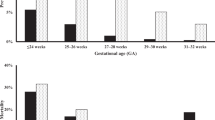Abstract
Objective:
To examine whether antenatal steroids (ANS), alone or with early indomethacin, are associated with spontaneous intestinal perforation (SIP). SIP is a known complication of concurrent post-natal administration of glucocorticoid and indomethacin in extremely low birth weight (ELBW) infants.
Study design:
A large de-identified national data set was retrospectively examined for infants with SIP without any report of other malformation or necrotizing entrocolitis. A control group was then derived matching for gender and birth weight (±20?g). Pre- and post-natal variables were tested by both univariate and multivariate analysis to identify associations with SIP.
Results:
From January 1996 to June 2004, there were 2?27?711 discharges from Pediatrix neonatal intensive care unit sites. From this population 388 infants with SIP associated with ELBW were compared to matched controls. Infants with SIP were more likely to have received early indomethacin and to have received a combination of early indomethacin with post-natal glucocorticoids (P<0.05 for both). When used alone (without subsequent indomethacin), ANS showed no association with SIP. When used in conjunction with indomethacin, ANS did not increase the rate of SIP beyond indomethacin alone.
Conclusion:
ELBW Infants that acquire SIP were more likely to have been exposed to early indomethacin and post-natal glucocorticoids. However, no association was found between SIP and ANS within a well-powered cohort.
This is a preview of subscription content, access via your institution
Access options
Subscribe to this journal
Receive 12 print issues and online access
$259.00 per year
only $21.58 per issue
Buy this article
- Purchase on Springer Link
- Instant access to full article PDF
Prices may be subject to local taxes which are calculated during checkout
Similar content being viewed by others
References
Liggins GC, Howie RN . A controlled trial of antepartum glucocorticoid treatment for prevention of the respiratory distress syndrome in premature infants. Pediatrics 1972; 50: 515–525.
Crowley P . Prophylactic corticosteroids for preterm birth. Cochrane Database Syst Reviews 2006, Issue 3. Art No: CD000065. doi:10.1002/14651858.CD00065.pub2.
Papageorgiou AN, Desgranges MF, Masson M, Colle E, Shatz R, Gelfand MM . The antenatal use of betamethasone in the prevention of respiratory distress syndrome: a controlled double-blind study. Pediatrics 1979; 63: 73–79.
Gamsu HR, Mullinger BM, Donnai P, Dash CH . Antenatal administration of betamethasone to prevent respiratory distress syndrome in preterm infants: report of a UK multicentre trial. Br J Obstet Gynaecol 1989; 96: 401–410.
Attridge JT, Clark R, Walker MW, Gordon PV . New insights into spontaneous intestinal perforation using a national data set: (2) two populations of patients with perforations. J Perinatol 2006; 26: 185–188.
Gordon P, Rutledge J, Sawin R, Thomas S, Woodrum D . Early postnatal dexamethasone increases the risk of focal small bowel perforation in extremely low birth weight infants. J Perinatol 1999; 19: 573–577.
Gordon PV, Price WA, Stiles AD . Dexamethasone administration to newborn mice alters mucosal and muscular morphology in the ileum and modulates IGF-I localization. Pediatr Res 2001; 49: 93–100.
Stark AR, Carlo WA, Tyson JE, Papile LA, Wright LL, Shankaran S et al. Adverse effects of early dexamethasone in extremely-low-birth-weight infants. N Engl J Med 2001; 344: 95–101.
Watterberg KL, Gerdes JS, Cole CH, Aucott SW, Thilo EH, Mammel MC et al. Prophylaxis of early adrenal insufficiency to prevent bronchopulmonary dysplasia: a multicenter trial. Pediatrics 2004; 114: 1649–1657.
Gordon PV . Weighing statistical certainty against ethical, clinical, and biologic expediency: the contributions of the Watterberg trial tip the scales in the right direction. Pediatrics 2005; 115: 1446–1447.
Watterberg K . Author reply. Pediatrics 2005; 115: 1447.
Gordon PV . Postnatal dexamethasone for lung disease of prematurity. N Engl J Med 2004; 350: 2715–2718.
Attridge JT, Clark R, Walker MW, Gordon PV . New insights into spontaneous intestinal perforation using a national data set: (1) SIP is associated with early indomethacin exposure. J Perinatol 2006; 26: 93–99.
Gordon PV, Moats-Staats BM, Stiles AD, Price WA . Dexamethasone changes the composition of insulin-like growth factor binding proteins in the newborn mouse ileum. J Pediatr Gastroenterol Nutr 2002; 35: 532–538.
Gordon PV, Price WA, Stiles AD, Rutledge JC . Early postnatal dexamethasone diminishes transforming growth factor alpha localization within the ileal muscularis propria of newborn mice and extremely low-birth-weight infants. Pediatr Dev Pathol 2001; 4: 532–537.
Gordon PV, Marshall DD, Stiles AD, Price WA . The clinical, morphologic, and molecular changes in the ileum associated with early postnatal dexamethasone administration: from the baby's bowel to the researcher's bench. Mol Genet Metab 2001; 72: 91–103.
Lee DK, Stern M, Solomon S . Cytoplasmic glucocorticoid receptors in the developing small intestine of the rabbit fetus. Endocrinology 1976; 99: 379–388.
Hundertmark S, Buhler H, Fromm M, Kruner-Gareis B, Kruner M, Ragosch V et al. Ontogeny of 11beta-hydroxysteroid dehydrogenase: activity in the placenta, kidney, colon of fetal rats and rabbits. Horm Metab Res 2001; 33: 78–83.
Claus R, Raab S, Lacorn M . Activities of 11beta-hydroxysteroid dehydrogenase 2 in different regions of the intestinal tract of pigs. Exp Clin Endocrinol Diabetes 2001; 109: 374–377.
Author information
Authors and Affiliations
Corresponding author
Rights and permissions
About this article
Cite this article
Attridge, J., Clark, R. & Gordon, P. New insights into spontaneous intestinal perforation using a national data set (3): antenatal steroids have no adverse association with spontaneous intestinal perforation. J Perinatol 26, 667–670 (2006). https://doi.org/10.1038/sj.jp.7211589
Received:
Revised:
Accepted:
Published:
Issue Date:
DOI: https://doi.org/10.1038/sj.jp.7211589
Keywords
This article is cited by
-
Prophylactic indomethacin, antenatal betamethasone, and the risk of intestinal perforation in infants <28 weeks’ gestation
Journal of Perinatology (2023)
-
Spontaneous intestinal perforation in premature infants: a national study
Journal of Perinatology (2021)
-
Intestinal perforation in very preterm neonates: risk factors and outcomes
Journal of Perinatology (2015)
-
Improved Closure of Patent Ductus Arteriosus With High Doses of Ibuprofen
Pediatric Cardiology (2012)
-
Prenatal or postnatal indomethacin exposure and neonatal gut injury associated with isolated intestinal perforation and necrotizing enterocolitis
Journal of Perinatology (2010)



